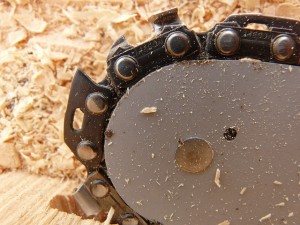 Print a Sign-In Sheet | Spanish Version
Print a Sign-In Sheet | Spanish Version
Operating a chain saw is inherently hazardous. Potential injuries can be minimized by using proper personal protective equipment (PPE) and safe operating procedures.
Before Starting a Chain Saw
- Check controls, chain tension, and all bolts and handles to ensure they are functioning properly and adjusted according to the manufacturer’s instructions.
- Make sure the chain is always sharp and lubrication reservoir is full.
- Start the saw on the ground or on another firm support. Drop starting is never allowed.
- Start the saw at least 10 feet from the fueling area with the chain’s brake engaged.
Fueling a Chain Saw
- Use approved containers for transporting fuel to the saw.
- Dispense fuel at least 10 feet away from any sources of ignition when performing construction activities. No smoking during fueling.
- Use a funnel or flexible hose when pouring fuel into the saw.
- Never attempt to fuel a running or hot saw.
Chain Saw Safety
- Clear away dirt, debris, small tree limbs, and rocks from the saw’s chain path. Look for nails, spikes, or other metal in the tree before cutting.
- Shut off the saw or engage its chain brake when carrying the saw on rough or uneven terrain.
- Take time to inspect the tree for dead branches prior to cutting.
- Ensure all tripping hazards are removed from the work area prior to cutting operations.
- Establish a clear path for retreat in case of emergency.
- Keep your hands on the saw’s handles and maintain secure footing while operating the saw.
- Proper PPE must be worn when operating the saw, which includes hand, foot, leg, eye, face, hearing, and head protection.
- Do not wear loose-fitting clothing.
- Be careful that the trunk or tree limbs will not bind against the saw.
KEMI does not assume liability for the content of information contained herein. Safety and health remain your responsibility. This information is to be used for informational purposes only and not intended to be exhaustive or a substitute for proper training, supervision, or manufacturers’ instructions/recommendations. KEMI, by publication of this information, does not assume liability for damage or injury arising from reliance upon it. Compliance with this information is not a guarantee or warranty that you will be in conformity with any laws or regulations nor does it ensure the absolute safety of any person, place, or object, including, but not limited to, you, your occupation, employees, customers, or place of business.

